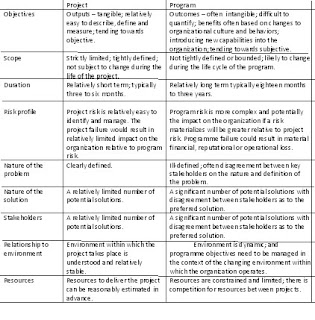Project Vs Program.

Introduction Many people are uncertain about the difference between a project and a program (also please refer to note on spelling conventions used on ICB.com). Management consultants are regularly involved in supporting clients through periods of complex change and consequently clarity on the basic definitions of a project and a program, and the difference between a project and a program are important. It is also important that management consultants use consistent terms and language when describing work to be undertaken in order that the client can understand the nature and scale of the consulting intervention that will be required. Although many of the change management considerations are common between a program and a project, the nature of the consulting work required to support each type of initiative is quite distinct. Definition of a Project A project is a temporary entity established to deliver specific (often tangible) outputs in line with predefined time, cost an




